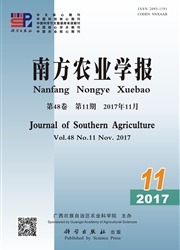

 中文摘要:
中文摘要:
【目的】评价不同DNA条形码候选序列对荨麻科植物的鉴别能力,为荨麻科植物鉴定提供参考。【方法】使用ITS、matK、rbcL和psbA-trnH序列的通用引物对荨麻科植物进行PCR扩增和测序,比较各序列的扩增效率、测序成功率,分析获得序列的碱基组成及变异,比较种间和种内变异的差异,并对条形码间距进行评估。【结果】psbA-trnH序列在荨麻科植物13个种30个样品中的扩增成功率最高(100.0%)。psbA-trnH的有效序列获得率最高,为95.4%,ITS为92.3%,rbcL为90.1%,matK为零。ITS序列种间遗传距离范围为0~0.508,psbA-trnH序列为0~0.522,rbcL序列为0~0.532。ITS序列在种间、种内的差异变异及条形码间距较rbcL与psbA-trnH具有更明显的优势。ITS序列构建的系统发育树中不同物种形成单系分支的百分比最高,其次为psbA-trnH、rbcL序列。聚类结果表明,MP法的聚类效果最好,其次为UPGMA法、ML法,NJ法最不理想。【结论】荨麻科植物种间变异明显大于种内变异,DNA条形码适用于荨麻科植物种水平上的鉴定;3个候选序列中无任何一个序列可完全鉴别出不同种类的荨麻科植物,ITS、rbcL与psbA-trnH可作为鉴别荨麻科植物的DNA条形码序列组合。
 英文摘要:
英文摘要:
【Objective】Identification ability of DNA barcode sequences for Urticaceae plants was evaluated to provide references for Urticaceae plants identification. 【Method】DNA fragments of 4 hot regions(ITS,matK,rbcL and psbA-trnH) were amplified by PCR and sequenced using universal primers from Urticaceae family to compare PCR amplification efficiency and sequencing success rate. The nucleotide constitution and mutation of sequences were analyzed to compare inter-and intraspecific divergences and estimate barcoding gap. 【Result】psbA-trnH region had the highest amplification efficiency(100.0%) in 30 plant samples belonging to 13 Urticaceae species. The sequencing efficiency rate was the highest for psbA-trnH region, which was 95.4%. It was 92.3%, 90.1%, and 0 for ITS, rbcL and matK, respectively. The genetic distance of ITS sequences was from 0 to 0.508. The genetic distance of psbA-trnH sequence was from 0 to 0.522. The genetic distance of rbcL sequence was from 0 to 0.532. ITS region had better inter-and intraspecific divergences and DNA barcoding gap than other tested regions(rbcL and psbA-trnH). The phylogenetic tree based on ITS sequence had the highest percentage on a monophyletic clade for different species, and followed by psbA-trnH and rbcL sequences. The clustering results showed that the best method was MP, followed by UPGMA, ML and NJ. NJ method was the most unsatisfactory. 【Conclusion】The interspecific divergences were significantly bigger than the intraspecific divergences in Urticaceae plants. DNA barcode was suitable for identifying Urticaceae plants. Among all sequences in this study, no any single sequence could completely identify different types of Urticaceae species. ITS,rbcL and psbA-trnH can be used as a combination of DNA barcode sequence to identify the species in Urticaceae.
 同期刊论文项目
同期刊论文项目
 同项目期刊论文
同项目期刊论文
 期刊信息
期刊信息
